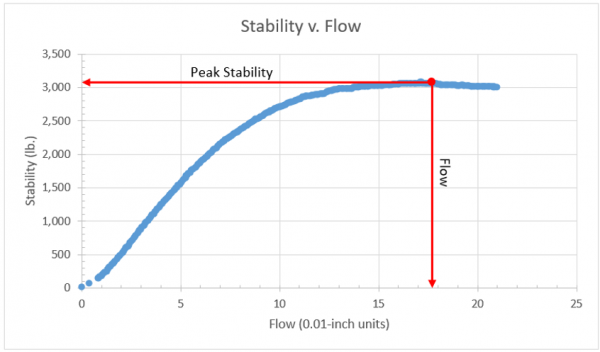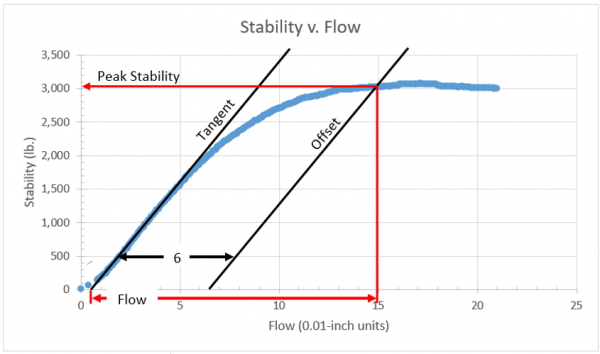Technical Bulletin 20201026
Clarification of Peak Load and Flow
Purpose: The purpose of this technical bulletin is to clarify the Marshall Test results reported by the Pine 850 Marshall Test Press outfitted with a digital recorder. This bulletin does not apply to a Test Press outfitted with a paper recorder.
The Standard Applied:
AASHTO T 245-15 (2019) Standard Test Method for Resistance to Plastic Flow of Asphalt Mixtures Using Marshall Apparatus Section 5.3 … Record the maximum load noted … Release the flowmeter sleeve or note the micrometer dial reading, where used, the instant the maximum load begins to decrease.
Clarification: The Marshall Test results displayed by the machine are the peak stability recorded during a test and the flow associated with that point of maximum stability as indicated in Figure 1.

Options for Further Analysis: Pine provides Excel® Workbooks for further analysis and plotting of the data. The workbooks have been renamed, updated, and they are available for download here, https://cloud.pineinstrument.com/owncloud/s/DqiwZd7Kba7ZpNj.
850 AASHTO T 245 Marshall Workbook (formerly 850 Marshall Workbook) identifies the peak load and stability as is presented on the digital display of the machine and shown in Figure 1. Additionally, the data is plotted for visual or printing purposes.
850 ASTM D6927 Marshall Alternative Method Workbook (formerly 850TD Marshall Method B Workbook) allows the user to analyze the stability and flow data using the alternative method described in ASTM D6927-15 Section 4 in which a line tangent to the linear part of the increasing load curve is offset by 6 flow units. Peak load is identified at the intersection between the offset line and the data curve. Flow is the flow associated with the peak load less the flow value where the tangent line intersects the flow axis. Figure 2 shows this method. The data is also plotted in the workbook for visual and printing purposes.
Establishing the line tangent to the linear part of the increasing load curve requires user judgment. The workbook gives the user two methods for establishing this tangent line.
ASTM D6927-15 specifies an offset of 6 flow units. The workbook sets the offset at 6 flow units, but allows the user to change the offset if it is desired to do so.




